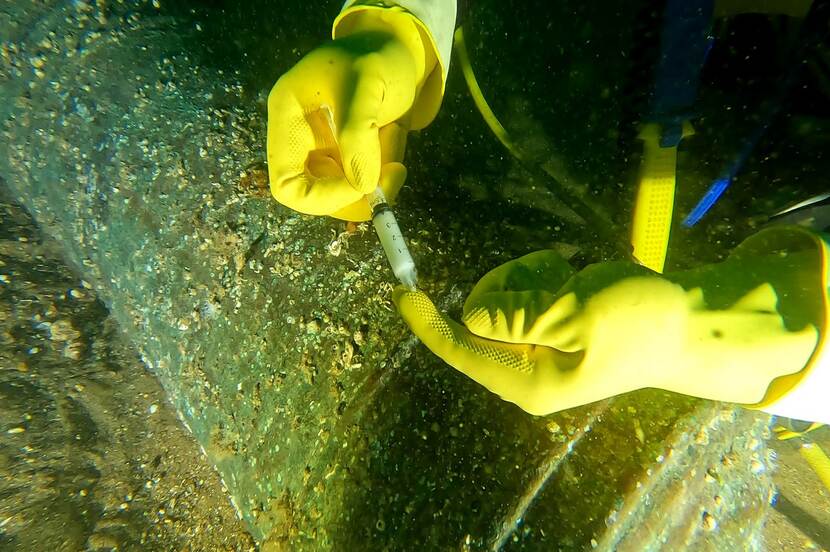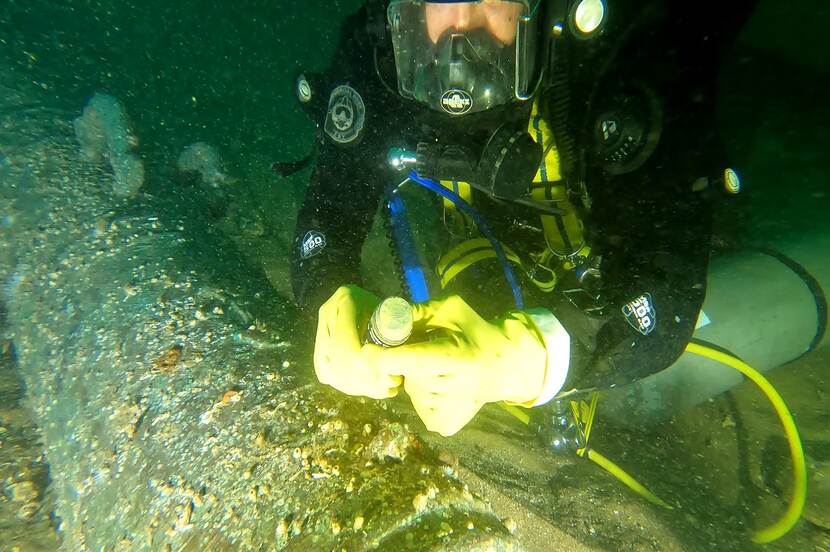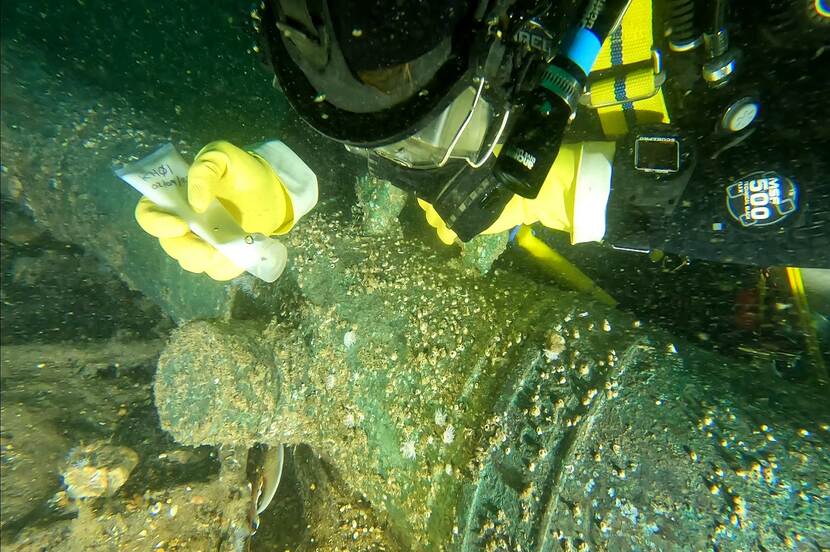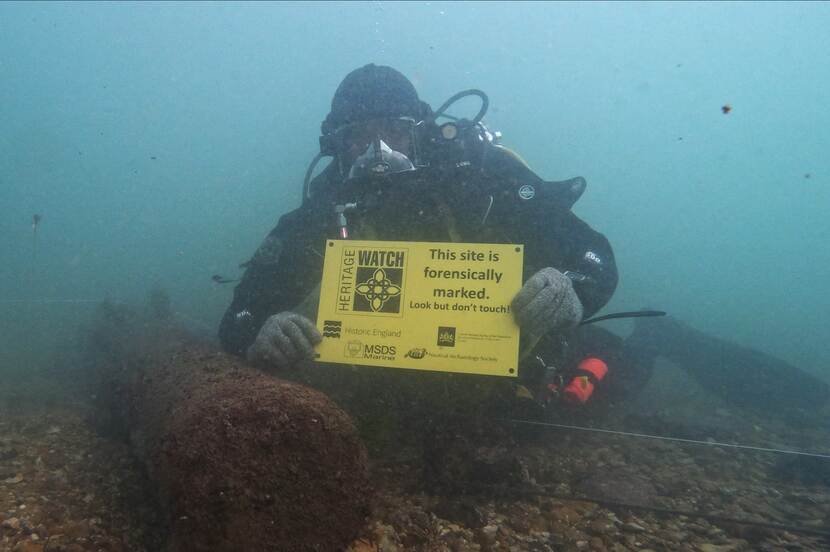Innovative marking technology will help protect shipwrecks such as the Klein Hollandia from heritage crime
A team of Dutch and English maritime archaeologists forensically marked objects of the Klein Hollandia (1653-1672) shipwreck in early September. Marking these artefacts gives them even greater protection as they will now be traceable. This project by the Cultural Heritage Agency of the Netherlands (RCE), Historic England, MSDS Marine, and partners is sending a direct message to potential thieves that underwater artefacts such as cannons on UK's Protected Wreck Sites are ‘too hot to handle', marking a step forward in protecting important historical wrecks.
After the theft of the three Dutch warships Hr.Ms. De Ruyter, Hr.Ms. Java and Hr.Ms. Kortenaer from the Java Sea, the RCE started developing the technique of forensic marking. The RCE does this in close cooperation with partners Historic England (as part of their Heritage Watch Scheme) and MSDS Marine. The wreck of the Klein Hollandia has long been under investigation in collaboration with the Nautical Archaeology Society (NAS). The aim is to gather a chain of conclusive evidence that will be usable in court. To achieve this, other complementary methods are also under development. The RCE also works together with the Information and Heritage Inspectorate and the Dutch Military Intelligence and Security Service.
[Text continues underneath the photo]

When third parties take parts of the marked vessels, these will be traceable. The material used to mark the objects remains even after flushing and spreads to the people handling the object and everything else that comes into contact with the objects brought to the surface. A veritable nightmare, therefore, for trespassers. Upon discovery, the material can be read to identify exactly which wreck the object came from. These markers have been tested for environmental contamination and applicability in nature.
This is an important step forward for the protection of underwater cultural heritage
, said Martijn Manders, coordinator International Maritime Heritage at the RCE. We are doing this because, in some cases, we also want to leave heritage on the bottom for others to enjoy, or even emotionally bond with. I am thinking of cannons on shipwrecks that are often visited by sports divers, for example, but also of war graves at sea that we want to leave alone as much as possible.
[Text continues underneath the photo]

Importance of protecting shipwrecks
With maritime archaeological and cultural-historical research on shipwrecks like the Klein Hollandia, not only tangible remains but also stories come to the surface. These provide valuable knowledge and important insights into moments in shared maritime history of the Netherlands and other countries. Without responsible management, wrecks like this one disappear, and excavation is not always an option. The UK and the Netherlands are therefore working closely together to preserve their shared maritime heritage.
Duncan Wilson, Chief Executive of Historic England said: Our nationally important shipwrecks tell the story of England’s maritime past. Underwater forensic marking of artefacts is a great leap forward in helping to protect them. We are pleased to be working with the Cultural Heritage Agency of the Netherlands on this project and to further our research into the 17th century Dutch warship Klein Hollandia. International collaboration like this is so important for preserving our shared maritime heritage.
Manders adds We are confident that forensic marking will help protect important cultural heritage such as the wreck of the Klein Hollandia. Without this protection this heritage will disappear. We appreciate the partnership with Historic England and MSDS Marine in developing this newest technique, working towards bringing offenders to justice together
.
[Text continues underneath the photo]

Further research Klein Hollandia
Built in 1654 and owned by the Admiralty of Rotterdam, this 17th century Dutch warship was involved in all major battles in the second Anglo-Dutch war (1665-1667). The mystery surrounding its identity was solved earlier this year after it was previously referred to as ‘the Unknown Wreck off Eastbourne’. It lies at a depth of 32 metres on the seabed and sank after being boarded and captured by the English, during an attack on the Dutch Smyrna convoy in 1672.
Discovered in 2019, the Klein Hollandia was considered so important that it was granted the highest level of protection in the same year. The condition of the wreck is remarkable and can offer a wealth of information about how 17th century Dutch ships were built and the activities of the warship during its final voyage. Archaeological remains for wrecks pre-dating 1700 are rare, and there is little surviving documentary evidence about how Dutch warships were built and modified over their lifetime. The Klein Hollandia saw a great deal of action at sea.
The latest dives (5th – 10th September 2023) provided an opportunity for maritime archaeologists to record and gather photographic evidence to research the surviving features of this historically important shipwreck, such as the unusual double layer of well-preserved Oak planking on its hull as well as possibly two additional layers of planking made from coniferous wood.
Find out more about the Klein Hollandia on MaSS or on the webpage on Maritime Heritage.
